Simon Cook’s Nuffield Thoughts: Part 2
The second core component of our Nuffield experience is the Global Focus Program or GFP. The GFP is a 6 week 6-7 nation intensive tour with a group of around 6 to 10 scholars. The program aims to show scholars a mix of agricultural, cultural and political practices in a range of different countries. My GFP will take in Singapore, India, UAE, Qatar, France, Belgium and the USA.
Our GFP started at the beginning of June in the heat and humidity of Singapore, a bit of a shock after coming out of the cold and wet of late Autumn in New Zealand. All three second half GFP’s had a few days being briefed about where Singapore and the wider asian economy’s were at before we all headed our seperate ways. Our briefings came from the ANZ bank, Meat and Livestock Australia and finally Syngenta. The Syngenta visit was of particular interest to me with discussions around upcoming chemicals and their involvement in new technologies to assist in crop protection. The two I was particularly interested in were the use of drones for spraying, and the recent purchase of a company developing an app that using a smartphones camera can identify a pest. I can see this having a great deal of benefit in assisting with the identification of new and unusual pests that may be the result of a Biosecurity incursion.
After leaving Singapore and having a brief stop over in Kuala Lampur we finally arrived late into Chennai, India at about midnight and were met by our local guide Ramesh. We walked out of the airport and straight into the heat and noise of India. Despite being almost midnight it was still late 30’s in temperature. With the sounds of car horns and people yelling ringing in our ears we jumped into taxis and headed out for our first introduction into Indian traffic. It was a blend of absolute hilarity mixed with abject fear for our lives as we made the 20 minute journey to the hotel. I will try later to expand on what the traffic is like in India, but I think words alone can’t do it justice – it has to be seen to be believed. We were only at our hotel for about 6 hours, before heading back to the airport to fly up to Salem, an hour south of Chennai.
We were met a Salem airport by a mini bus and headed back out into the traffic. Our journey took us out of Salem and up into the hills near Yercauld. The climb up to Yercauld was one of the most epic hill climbs I have ever seen with a twisting climb of around 1000m and a countdown of 20 tight hairpin corners as we neared the summit. Once we got to 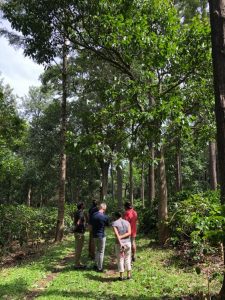 the top of the hill and headed inland the driver, unsure of our directions asked the helpful locals for directions. The locals eagerly gave us directions pointing us completely in the wrong direction a number of times. The result was a fantastic hour long tour of the local area which was mainly coffee plantation covered by an overhead canopy of mature trees, a truely beautiful area to explore. Despite the misdirections we finally found our way to the Last Shola Cottages, our accomodation for the night. The cottages, once worker accomodation set in the middle of the Gowri Estate coffee plantation, are now rented out to tourists. The cottages are part of a plan to diversify income to protect against volatile coffee prices. We met the owner Mohan Rajes and his son Navin, who had studied law at university in New Zealand and then spent time working in Sydney before returning to help run the family business. The next day we spent learning the history of the area and all about the local coffee industry. We were also warned to be on the lookout for bison who roamed wildly around the property and liked to charge at people especially when they had young. Given they are protected there is nothing the farmers and their staff can do but remain alert and be prepared to run, not sure what health and safety would make of that in New Zealand. We visited the coffee bean washing and drying area which also had a nursery growing a number of different plants including flowers for the local market, further evidence of a strong desire to diversify and explore new opportunities. We had afternoon tea at the family house originally built for a British family back when they controlled India. We finished the day with a tour of the family’s storage and processing facility that looked after the families and the wider districts coffee bean production.
the top of the hill and headed inland the driver, unsure of our directions asked the helpful locals for directions. The locals eagerly gave us directions pointing us completely in the wrong direction a number of times. The result was a fantastic hour long tour of the local area which was mainly coffee plantation covered by an overhead canopy of mature trees, a truely beautiful area to explore. Despite the misdirections we finally found our way to the Last Shola Cottages, our accomodation for the night. The cottages, once worker accomodation set in the middle of the Gowri Estate coffee plantation, are now rented out to tourists. The cottages are part of a plan to diversify income to protect against volatile coffee prices. We met the owner Mohan Rajes and his son Navin, who had studied law at university in New Zealand and then spent time working in Sydney before returning to help run the family business. The next day we spent learning the history of the area and all about the local coffee industry. We were also warned to be on the lookout for bison who roamed wildly around the property and liked to charge at people especially when they had young. Given they are protected there is nothing the farmers and their staff can do but remain alert and be prepared to run, not sure what health and safety would make of that in New Zealand. We visited the coffee bean washing and drying area which also had a nursery growing a number of different plants including flowers for the local market, further evidence of a strong desire to diversify and explore new opportunities. We had afternoon tea at the family house originally built for a British family back when they controlled India. We finished the day with a tour of the family’s storage and processing facility that looked after the families and the wider districts coffee bean production.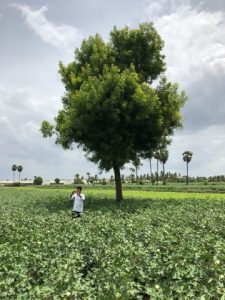
We then headed back down the hill and into Salem for the night. The next morning we headed out and visited a cotton weaving plant that took completed yarn and wove it into sheets of material that were then manufactured into a wide range of cotton shirts. After a brief tour we headed out to see where the process began by visiting an organic cotton farm. The only inputs to the farm were from manure derived from the farmers goats and cows. The crop alternated between cotton during summer and maize over winter which was then fed to the farmers stock meaning a predominantly closed loop. Protection from insects came from extracts from locally growing plants like the Neem tree which is commonly used on organic orchards in New Zealand in the form of Neem Oil. The farm was benefiting from the advice from a Government funded project to encourage and support growers to take up organic growing as an alternative to using pesticides.
We were dropped back to our accommodation for our final night in Salem before heading back to Chennai the following day. Our flight arrived around lunchtime and we headed off to the MSME development institute that specialised in helping small to medium business. One of the businesses they were currently working with was a spirulina manufacturer. We went out and had a tour of their facilities and learnt how spirulina is grown, dried and prepared for sale. The site was also involved with research into fish breeding, solar power generation, natural gas production from cow manure, chicken and goat rearing, all aimed at helping small isolated farms become more efficient and therefore profitable.
Our final day in the south of  India started early with a 5am departure to the local fruit and vegetable markets. I have visited a number of fruit markets around the world but this was a whole new experience. The noise, the mess, the bustling people, not to mention the odd cow wandering freely around the middle of the market, it was definitely an experience I will not forget any time soon. The rest of the day was spent visiting the MS Swaminathan Foundation. The foundation was created with the vision of providing and supporting scientific research for the benefit of agriculture. One interesting project they had at the office was trying to encourage blind students to take up science and become involved in agriculture. They had an area setup with a number of different plants and trees for the students to explore by touch and smell with the plants common name and genus species available in brail.
India started early with a 5am departure to the local fruit and vegetable markets. I have visited a number of fruit markets around the world but this was a whole new experience. The noise, the mess, the bustling people, not to mention the odd cow wandering freely around the middle of the market, it was definitely an experience I will not forget any time soon. The rest of the day was spent visiting the MS Swaminathan Foundation. The foundation was created with the vision of providing and supporting scientific research for the benefit of agriculture. One interesting project they had at the office was trying to encourage blind students to take up science and become involved in agriculture. They had an area setup with a number of different plants and trees for the students to explore by touch and smell with the plants common name and genus species available in brail.
We then headed back to the airport, said farewell to Ramesh and headed North. It was a shame to leave Ramesh as he had been fantastic with his insights into Indian culture and agriculture. It was fascinating to learn that only 10% of the population actually pay tax with the rest receiving government support. In India no one actually needs to work to live with government payouts and subsidies providing a basic standard of living. This is having the obvious outcome of a large sector of the population having no interest in working. The agriculture sector is dominated by small subsistence style farms with very little consolidation into larger farms and as a result there is very little mechanisation and manual labour is still the mainstay. The ongoing financial support of growers will have the effect of maintaining the status quo and severely restricting India’s ability to increase productivity through mechanisation and scale. India is also going to face serious issues around water shortages as the population continues to swell placing pressure on all forms of infrastructure. It is a country growing rapidly and embracing technology but still struggling to maintain its old way off life, the two are not compatible and will result in significant cultural and economic changes being forced on the country in the not to distant future.
With the southern India part o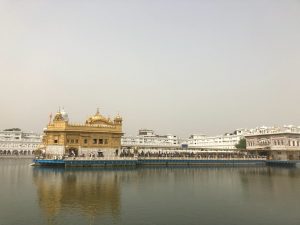 f our tour completed we flew North to the Punjab region. After changing planes in Delhi we flew North to Amritsar about 30 minutes drive from the border with Pakistan. We were met at Amritsar airport by our hosts for the Northern part of the tour Pavitar Pangali and Rajvinder Rana . We stayed the night in Amritsar and left early in the morning to visit Harmandir Sahib, The Golden Temple that is the centre of the Sikh religion. The temple contains the original scriptures that formed the basis of the Sikh religion. The surrounding structures contain accomodation and kitchens that provide over 100,000 free meals to visitors every day. There was a queue to enter the actual temple that took around 2 hours, endless to say we skipped this part and just enjoyed the outside view of the temple.
f our tour completed we flew North to the Punjab region. After changing planes in Delhi we flew North to Amritsar about 30 minutes drive from the border with Pakistan. We were met at Amritsar airport by our hosts for the Northern part of the tour Pavitar Pangali and Rajvinder Rana . We stayed the night in Amritsar and left early in the morning to visit Harmandir Sahib, The Golden Temple that is the centre of the Sikh religion. The temple contains the original scriptures that formed the basis of the Sikh religion. The surrounding structures contain accomodation and kitchens that provide over 100,000 free meals to visitors every day. There was a queue to enter the actual temple that took around 2 hours, endless to say we skipped this part and just enjoyed the outside view of the temple.
We hopped back in our bus and headed out of Amritsar and onto Ludhiana. On the way we stopped off at the Punjab Centre of Excellence for Vegetables. We had a quick introduction into the work that they did, but unfortunately, we were arriving in mid summer when they grow little due to the heat. We were instead able to see what they were doing in terms of researching low cost cool storage options for farmers. One innovation was a frame that sat over a refrigerated container with solar panels on it providing a cool storage option in areas without power. We also viewed some small cool stores utilising residential heat pumps to minimise costs. Inspecting cool stores brought a brief respite from the 40 deg temperatures outside.
In the afternoon we were given a tour of the privately owned Lovely Professional University which was established 2005 and has a strong agricultural department. It was founded by the Lovely family who had made money in confectionary and transport. The university now has 35,00 students who commute from as far as 100km away to attend the university each day. We had afternoon tea with the chancellor in his office which looked more like Dr Evils lair than an office. Our local hosts took the opportunity to continue to press for India to raise the sponsorship to produce its own Nuffield Scholar. 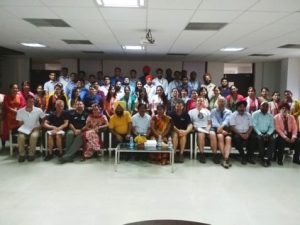
The following day was a long hot series of meetings at the Punjab Agricultural university. We were introduced to researches, deans and vice chancellors. The highlight of the day was being taken into a large room totally without warning and placed in front of 30 plus PhD researchers and professors for a panel discussion on issues surrounding agriculture. Power cuts that day didn’t help with visits often in hot offices struggling without any ventilation. We found out later even our local hosts were struggling with the heat and humidity of these visits. It ended up being a pretty frustrating day for the group with the visits adding little to our knowledge.
In the evening we visited the Cheetan mushroom factory where we were also hosted by the family for dinner. The son Cheetan who ran the business had been educated in California and relished the opportunity to entertain a group of similar aged westerners. Our poor India hosts were getting a bit worried as our hosts attempted to get us to consume as much alcohol as possible. It ended up a very relaxed and entertaining evening with a little more understanding of the culture around how traditional family’s operate. It was interesting to see the practice of arranged marriages still occurring with Cheetan’s marriage to his wife being arranged. In this case his wife was an old family friend and he was happy with the arrangement.
After the heat of the past few days it was a relief the next day when we got off the bus at the Borlaug Institute for Research, to much cooler and more comfortable conditions. The research projects we were shown focused on reducing the water footprint required to grow grain and rice crops. In particular they were looking at subsurface drip irrigation which could half the amount of water required to grow a wheat crop. At the moment there is no charge for water so there is no incentive to invest in subsurface irrigation, ho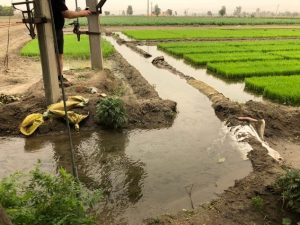 wever the research will no doubt prove invaluable as water becomes increasingly scarce. We learnt that bores across the Punjab region are dropping by up to 1.5m annually and if this continues the country will in the next decade be facing potentially severe water shortages, if nothing is done to change current practices. In the afternoon we visited rice farms where water is drawn from bores to completely flood paddocks when the rice is transplanted. Seeing a vast area of ground being prepared for rice planting you get a sense of the phenomenal volume of water that is going to be drawn out of the underground aquifers to produce this crop. It is staggering to see this practice continuing and the general feeling was the Government were unable to intervene to stop it for fear of voter backlash. The equivelant wheat crop only uses about a 10th of the water required for a rice crop, and with sub surface drip irrigation you can again halve the water required for a grain crop. Rice is not traditionally grown in this area, but in an effort to be self sufficient the Indian Government put guarantees in place for the price of rice encouraging growers to start producing it in areas that naturally are just not suited to its production.
wever the research will no doubt prove invaluable as water becomes increasingly scarce. We learnt that bores across the Punjab region are dropping by up to 1.5m annually and if this continues the country will in the next decade be facing potentially severe water shortages, if nothing is done to change current practices. In the afternoon we visited rice farms where water is drawn from bores to completely flood paddocks when the rice is transplanted. Seeing a vast area of ground being prepared for rice planting you get a sense of the phenomenal volume of water that is going to be drawn out of the underground aquifers to produce this crop. It is staggering to see this practice continuing and the general feeling was the Government were unable to intervene to stop it for fear of voter backlash. The equivelant wheat crop only uses about a 10th of the water required for a rice crop, and with sub surface drip irrigation you can again halve the water required for a grain crop. Rice is not traditionally grown in this area, but in an effort to be self sufficient the Indian Government put guarantees in place for the price of rice encouraging growers to start producing it in areas that naturally are just not suited to its production.
We also squeezed a quick visit that afternoon into FieldFresh Foods, a manufacturing company focussing on packing baby corn and  a range of other vegetables into jars for sale. They were supplying international companies like Del Monteand had achieved Tesco and GlobalGap certification. The hygiene and food safety standards were a significant step change from previous facilities we had visited, and despite pressure being put on the woman enforcing our compliance by the local hosts we all had to go through the process of signing in. In what is still a very male dominated society it took significant bravery for a woman stand up to the pressure to not allow the local Minister of Agriculture to bypass the signing in process. Inside the factory was clean and modern with significant effort made to ensure it would comply with global health standards. Having been in a dairy factory the day before where welding was occurring in the middle of the factory whilst milk was being packed, these standards are far from universal.
a range of other vegetables into jars for sale. They were supplying international companies like Del Monteand had achieved Tesco and GlobalGap certification. The hygiene and food safety standards were a significant step change from previous facilities we had visited, and despite pressure being put on the woman enforcing our compliance by the local hosts we all had to go through the process of signing in. In what is still a very male dominated society it took significant bravery for a woman stand up to the pressure to not allow the local Minister of Agriculture to bypass the signing in process. Inside the factory was clean and modern with significant effort made to ensure it would comply with global health standards. Having been in a dairy factory the day before where welding was occurring in the middle of the factory whilst milk was being packed, these standards are far from universal.
We spent the next day driving the 300 plus km from Ludhiana back down to Delhi. Unfortunately late morning, with temperatures climbing into the 40s, our air conditioning started packing up. Fortunately we were able to overcome some of the heat with the judicious application of Bira, a local brand of beer we managed to find at a roadside store. As we neared Delhi the traffic ratcheted up to a whole new level of insanity. I came to the conclusion that the most unrewarding job in India must be road marking, as the lines deviding lanes seem completely irrelevant to the local drivers who drive wherever they want and a 3 lane highway ends up 5 or 6 lanes wide. The most interesting aspect is on the open road the inside lane is the slow lane, as is also the outside lane. Somewhere in the middle weaving in and out between cars is the fast lane. A great system for preventing driver fatigue as you are constantly having to swerve to avoid hitting something. As with everything in India whilst it seems like total chaos, it somehow seems to work. As we got closer to Delhi even 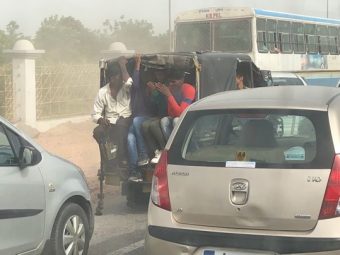 the dirt on the side of the road became fair game.
the dirt on the side of the road became fair game.
Our last full day in India started with a visit to Binsar Farms dairy farm on the outskirts of Delhi. Earl Rattray the former Fonterra director has been involved in helping set the operation up. The idea for the farm came from Pankash, a former computer engineer who recognised the need for India to improve its agricultural practices. Despite its difficulties the farm is now starting to operate efficiently producing high quality safe milk that would meet the highest standards anywhere. They are showing that commercial scale operations can successfully be run in India. They have had to battle local authorities and their understandings to develop a head that can produce consistent volumes. All measures in India are based on peak milk flow and not long term production so the stock favoured locally cannot over a season produce anywhere near what Binsar Farms are able to get.
After leaving Binsar Farm we headed to the slums of Delhi to meet with the Asha Community Health and development Society. The society have been working for a number of years to improve the lives of those living in the slums of India. Today they are operating in over 90 sites helping over 700,000 people. Their focus is providing basic healthcare and in particular immunisation to children and then helping with providing them with the education they need to work their way out of poverty. The education comes from volunteers who travel to India to donate their time teaching basic skills such as maths and english. We had a number of local women and children tell their stories about 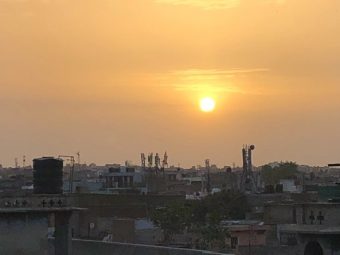 how the society had looked after them and improved their lives.
how the society had looked after them and improved their lives.
Our final visit in India was to the Delhi spice markets where we hired rickshaws to take us around. The highlight was our rickshaw drivers taking us into a random building and up onto the roof giving us an amazing view over the spice markets and Delhi as the sun set. As we entered the building on our way to the roof we were all hit by the overwhelming strength of spices and were left sneezing and coughing but the view at the end was worth it. Like a lot of things in India the hardest to reach places were often the most rewarding and the difficulties soon forgotten.
